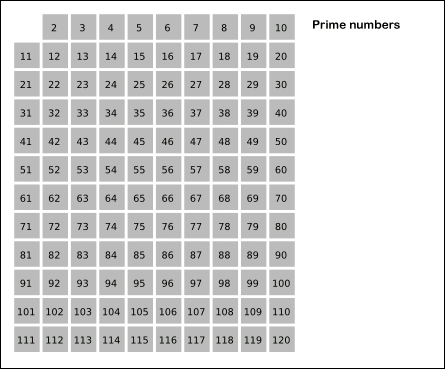找出小于N的素数的数量。
-
$$ 暴力,空间O(1),时间O(N^{1.5}) $$ As we know the number must not be divisible by any number > n / 2, we can immediately cut the total iterations half by dividing only up to n / 2.
所有数N,都不可能被大于N/2整除。
Let's write down all of 12's factors:
2 × 6 = 12 3 × 4 = 12 4 × 3 = 12 6 × 2 = 12As you can see, calculations of 4 × 3 and 6 × 2 are not necessary. Therefore, we only need to consider factors up to √n because, if n is divisible by some number p, then n = p × q and since p ≤ q, we could derive that p ≤ √n.
由上图可知,只需要考虑小于等于√N的数。
证明:如果N可以被P整除,就存在数Q,满足N=P * Q。
因为P<=Q,所以P<=√N。
public int countPrimes(int n) { int count = 0; for (int i = 1; i < n; i++) { if (isPrime(i)) { count++; } } return count; } private boolean isPrime(int num) { if (num <= 1) return false; // Loop's ending condition is i * i <= num instead of i <= sqrt(num) // to avoid repeatedly calling an expensive function sqrt(). for (int i = 2; i * i <= num; i++) { if (num % i == 0) { return false; } } return true; }
-
筛选法(有点自底向上的味道),空间O(N),时间O(NlogN)。
We start off with a table of n numbers. Let's look at the first number, 2. We know all multiples of 2 must not be primes, so we mark them off as non-primes. Then we look at the next number, 3. Similarly, all multiples of 3 such as 3 × 2 = 6, 3 × 3 = 9, ... must not be primes, so we mark them off as well.
观察2:所有2的倍数都不是素数,将它们标记位非素数。
观察3:也一样。
4 is not a prime because it is divisible by 2, which means all multiples of 4 must also be divisible by 2 and were already marked off. So we can skip 4 immediately and go to the next number, 5.
观察4:4不是一个素数,因为它可以被2整除,并且它和它的倍数已经被标记,所以直接跳过。
In fact, we can mark off multiples of 5 starting at 5 × 5 = 25, because 5 × 2 = 10 was already marked off by multiple of 2, similarly 5 × 3 = 15 was already marked off by multiple of 3.
观察5:我们可以从5 * 5 = 25开始标记,因为 5 * 2 = 10已经作为2的倍数被标记了,就正如15已经作为3的倍数被标记了。
Therefore, if the current number is p, we can always mark off multiples of p starting at p^2, then in increments of p: p^2 + p, p^2 + 2p, ...
因此,对于当前数字P,我们总是从P ^ 2平方开始标记,然后以P递增标记后面的倍数。
The terminating loop condition can be p < √n, as all non-primes ≥ √n must have already been marked off. When the loop terminates, all the numbers in the table that are non-marked are prime.
回想第一种解法,可以得知:循环终止的条件是 P < √N,因为所有大于或等于√N的非素数都肯定已经被标记了。
public int countPrimes(int n) { if(n <= 2) { return 0; } boolean[] notPrime = new boolean[n]; // Loop's ending condition is i * i < n instead of i < sqrt(n) // to avoid repeatedly calling an expensive function sqrt(). for (int i = 2; i * i < n; i++) { if (notPrime[i]) { continue; } for (int j = i * i; j < n; j += i) { notPrime[j] = true; } } int count = 0; for (int i = 2; i < n; i++) { if (!notPrime[i]) { count++; } } return count; }
